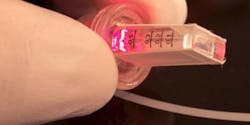Optogenetic method controls gene expression in thoughts
A team of researchers at ETH Zurich's Department of Biosystems Science and Engineering (D-BSSE; Basel, Switzerland) has developed an optogenetic gene regulation method that enables thought-specific brainwaves to control the conversion of genes into proteins (gene expression). The scientists envision that their method could someday be used to combat neurological diseases.
Related: Optogenetics controls timing, duration of gene expression in cells
"For the first time, we have been able to tap into human brainwaves, transfer them wirelessly to a gene network, and regulate the expression of a gene, depending on the type of thought. Being able to control gene expression via the power of thought is a dream that we've been chasing for over a decade," says Martin Fussenegger, Professor of Biotechnology and Bioengineering at D-BSSE.
The method they developed makes use of an electroencephalogram (EEG) headset. The recorded brainwaves are analyzed and wirelessly transmitted via Bluetooth to a controller, which in turn controls a field generator that generates an electromagnetic field; this supplies an implant with an induction current. Then, an integrated LED lamp that emits light in the near-infrared (NIR) range turns on and illuminates a culture chamber containing genetically modified cells. When the NIR light illuminates the cells, they start to produce the desired protein.
The implant was initially tested in cell cultures and mice, and controlled by the thoughts of various test subjects. The researchers used secreted embryonic alkaline phosphatase (SEAP) for the tests, an easy-to-detect human model protein that diffuses from the culture chamber of the implant into the mouse's bloodstream.
To regulate the quantity of released protein, the test subjects were categorized according to three states of mind: bio-feedback, meditation, and concentration. Test subjects who played the Minecraft game on the computer (concentration) induced average SEAP values in the bloodstream of the mice. When completely relaxed (meditation), the researchers recorded very high SEAP values in the test animals. For bio-feedback, the test subjects observed the LED light of the implant in the body of the mouse and were able to consciously switch the LED light on or off via the visual feedback. This in turn was reflected by the varying amounts of SEAP in the bloodstream of the mice.
"Controlling genes in this way is completely new and is unique in its simplicity," explains Fussenegger. The light-sensitive optogenetic module that reacts to NIR light is a particular advancement. The light shines on a modified light-sensitive protein within the gene-modified cells and triggers an artificial signal cascade, resulting in the production of SEAP. Near-infrared light was used because it is generally not harmful to human cells, can penetrate deep into the tissue and enables the function of the implant to be visually tracked.
The system functions efficiently and effectively in the human-cell culture and human-mouse system. Fussenegger hopes that a thought-controlled implant could one day help to combat diseases such as chronic headaches, back pain, and epilepsy by detecting specific brainwaves at an early stage and triggering and controlling the creation of certain agents in the implant at exactly the right time.
Full details of the work appear in the journal Nature Communications; for more information, please visit http://dx.doi.org/10.1038/ncomms6392.
-----
Follow us on Twitter, 'like' us on Facebook, connect with us on Google+, and join our group on LinkedIn
Subscribe now to BioOptics World magazine; it's free!

